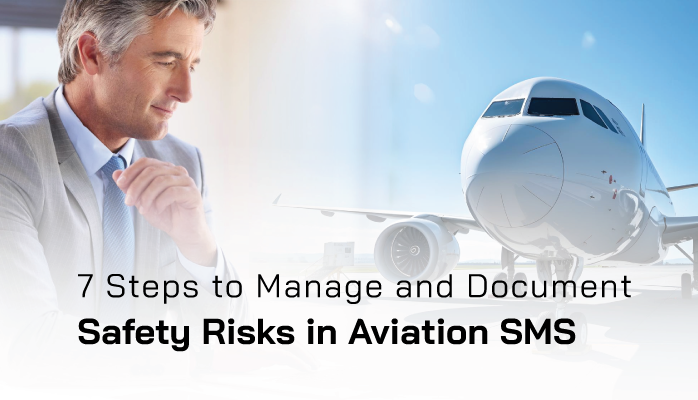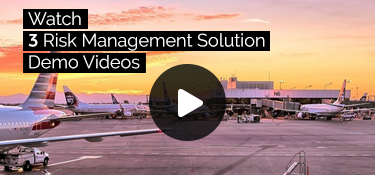Manage and Document Safety Risks in Aviation SMS

Managing and documenting safety risks is a cornerstone of an effective Safety Management System (SMS) in aviation. Required by the International Civil Aviation Organization (ICAO) and national regulators like the FAA and EASA, a robust risk management process helps airlines, airports, and other aviation organizations identify, assess, and mitigate hazards before they escalate into incidents.
Proper documentation ensures
- transparency,
- quick and efficient audit performance,
- regulatory compliance, and
- continuous improvement.
This article provides a step-by-step guide to managing and documenting safety risks in aviation SMS, offering practical strategies to enhance safety and streamline operations.
Why Managing and Documenting Safety Risks Matters
Effective risk management and documentation in aviation SMS implementations deliver critical benefits:
-
Proactive Safety: Identifying and mitigating risks prevents accidents, saving lives and reducing costs.
-
Regulatory Compliance: Proper documentation demonstrates adherence to ICAO Annex 19 and local regulations.
-
Data-Driven Decisions: Well-documented risks provide insights for improving operations and safety performance.
-
Audit Readiness: Clear records simplify audits and inspections by aviation authorities.
Poor risk management or inadequate documentation can lead to undetected hazards, regulatory penalties, or reputational damage. Here’s how to do it right.
1. Establish a Risk Management Framework
A structured risk management framework is essential for identifying, assessing, and mitigating safety risks systematically. This aligns with ICAO’s four SMS pillars:
- safety policy,
- risk management,
- safety assurance, and
- safety promotion.
How to Do It:
-
Define Processes: Adopt a risk management cycle: identify hazards, assess risks, implement controls, and monitor outcomes.
-
Set Roles and Responsibilities: Assign a safety manager to oversee risk management and involve cross-functional teams (e.g., pilots, maintenance, ground staff).
-
Use Standards: Follow ICAO’s risk management guidelines or tools like the FAA’s Safety Risk Management (SRM) process.
-
Create Templates: Develop standardized forms for hazard identification and risk assessment to ensure consistency.
Related Aviation Safety Articles
- How to Make Safety Reporting Forms for Aviation SMS - With Resources
- 10 Most Important Hazard Reporting Forms in Aviation SMS
- Examples of Good Hazard Reporting Forms in Aviation Safety
2. Identify Hazards Proactively
Hazard identification is the first step in managing safety risks. Hazards can arise from operations (e.g., runway incursions), human factors (e.g., fatigue), or external factors (e.g., weather).
How to Do It:
-
Encourage Reporting: Implement user-friendly reporting tools, like mobile apps or online forms, to collect hazard reports from all employees.
-
Conduct Audits: Perform regular safety audits and inspections to uncover latent risks, such as equipment wear or procedural gaps.
-
Analyze Data: Review incident reports, flight data, and maintenance logs to identify recurring issues. For example, a 2024 EASA report noted that 30% of near-miss incidents involved communication errors.
-
Engage Stakeholders: Hold safety workshops with frontline staff to gather insights on operational risks.
3. Assess and Prioritize Risks

Once hazards are identified, assess their likelihood and severity to prioritize mitigation efforts. This ensures resources are focused on the most critical risks.
How to Do It:
-
Use Risk Matrices: Apply a risk matrix (e.g., 5x5 grid) to score risks based on probability (unlikely to certain) and severity (negligible to catastrophic).
-
Involve Experts: Convene safety committees with pilots, engineers, and managers to evaluate risks collaboratively.
-
Quantify Impacts: Estimate potential costs or operational disruptions to justify mitigation. For instance, a runway incursion could cost millions in delays and repairs.
-
Prioritize High Risks: Focus on risks with high severity or frequent occurrence, such as bird strikes at busy airports.
4. Implement and Monitor Risk Controls
After prioritizing risks, implement controls to mitigate them and monitor their effectiveness over time.
How to Do It:
-
Select Controls: Choose measures like training, equipment upgrades, or procedural changes. For example, to reduce fatigue-related errors, mandate rest periods for crew.
-
Assign Accountability: Designate teams or individuals to implement and track each control.
-
Monitor Effectiveness: Use key performance indicators (KPIs), such as reduced incident rates, to evaluate controls. A 2023 FAA study found that enhanced training reduced human-error incidents by 12%.
-
Adjust as Needed: Update controls based on monitoring results or new hazards.
Related Aviation SMS Articles
- What Is a Risk Control in Aviation SMS: Meaning, Purpose, Application
- How to Monitor and Control Risk in Aviation SMS
- How to Monitor the Effectiveness of Control Measures
5. Document Risks and Actions Thoroughly
Comprehensive documentation is critical for compliance, audits, and continuous improvement. It creates a traceable record of risks, assessments, and mitigation efforts.
How to Do It:
-
Centralize Records: Use SMS software (e.g., SMS Pro) to store hazard reports, risk assessments, and control plans in a single, accessible system.
-
Standardize Formats: Create templates for risk registers, including fields for hazard description, risk score, controls, and follow-up actions.
-
Track Changes: Maintain version control to document updates to risk assessments or controls over time.
-
Ensure Accessibility: Make records available to auditors and safety teams while protecting sensitive data per GDPR or other regulations.
6. Leverage Technology for Efficiency
Technology streamlines risk management and documentation, reducing errors and saving time.
How to Do It:
-
Adopt SMS Software: Platforms like SMS Pro automate hazard logging, risk analysis, and reporting.
-
Use Mobile Tools: Enable real-time reporting via apps, allowing pilots or ground crew to submit hazards on the go.
-
Integrate Data: Link SMS tools with flight data monitoring or maintenance systems for comprehensive risk insights.
-
Train Staff: Ensure employees are trained to use digital tools effectively to maximize adoption.
7. Foster a Continuous Improvement Culture
Risk management is an ongoing process. A culture of continuous improvement ensures risks are managed dynamically as operations evolve.
How to Do It:
-
Review Regularly: Conduct quarterly risk reviews to update hazard logs and assess risk control effectiveness.
-
Share Lessons Learned: Distribute safety bulletins highlighting successful mitigations, like how a new taxiway design reduced ground collisions.
-
Engage Employees: Reward proactive reporting to sustain participation in risk identification.
-
Stay Updated: Monitor regulatory changes or industry trends (e.g., new drone risks) to adapt risk processes.
Conclusion
Managing and documenting safety risks in aviation SMS is a critical process that
- enhances safety,
- ensures compliance, and
- drives operational excellence.
By establishing a risk management framework, proactively identifying hazards, assessing and mitigating risks, documenting thoroughly, leveraging technology, and fostering continuous improvement, aviation organizations can build a resilient safety system.
Start implementing these strategies today to protect your operations and meet ICAO standards with confidence. Let SMS Pro reduce your SMS implementation burden!







